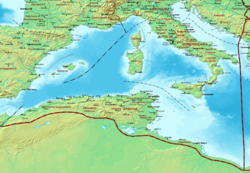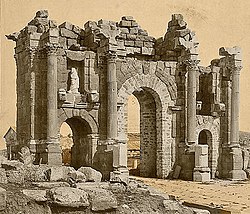Draft:Mina (Relizane)
 | Review waiting, please be patient.
This may take 8 weeks or more, since drafts are reviewed in no specific order. There are 2,731 pending submissions waiting for review.
Where to get help
How to improve a draft
You can also browse Wikipedia:Featured articles and Wikipedia:Good articles to find examples of Wikipedia's best writing on topics similar to your proposed article. Improving your odds of a speedy review To improve your odds of a faster review, tag your draft with relevant WikiProject tags using the button below. This will let reviewers know a new draft has been submitted in their area of interest. For instance, if you wrote about a female astronomer, you would want to add the Biography, Astronomy, and Women scientists tags. Editor resources
Reviewer tools
|
 Epitaph found in the ruins of Mina | |
| Location | Algéria |
|---|---|
| Region | Relizane |
Mina is one of the cities of Mauretania Caesarieansis [1], located west of the capital Caesarean . The site is 4 km from the city center of Relizane[2].
Geography
[edit]Location
[edit]
History
[edit]The city's existence, according to archaeological evidence, dates back to the 2nd century BC [3]. The Romans divided North Africa into provinces according to a specific policy aimed at strengthening their control over the region .Mauretania Caesarea was the largest of these provinces, stretching from the Moulouya River to the Ampsaga River Valley [4]. It was subject to the Romans immediately after Caligula's [5]accession to power in 40 AD, and all its cities, including Mina, were dependent on the capital, Caesarea.
The city witnessed many important historical events, such as local revolutions and those opposed to the policies of the Roman emperors in North Africa. However, it experienced a golden age between the 2nd and 3rd centuries AD [3].

The city continued to exist until the end of the Vandal reign in North Africa [6]. Many objects from excavations on the site, including a set of jewelry bearing witness to the Vandal
settlement in the town, are integrated into the collections of the National Archaeology Museum of Saint-Germain-en-Laye [7]
Religion
[edit]In the 1st century AD, Christianity emerged as a new religion in Palestine, attracting a large number of followers, prompting the Romans to seek to eliminate Christ and his disciples. However, it spread rapidly to Anatolia, Egypt, and North Africa [8].
Between the 2nd and 3rd centuries AD, a diocese was established in the city before Constantinople adopted Christianity. Among the major Christian gatherings attended by the city's priests was the Council of Carthage in 484 and 525 [9] during the Vandal period, which was the scene of violent revolts between local Arian and Donatist factions.
Legacy
[edit]Many objects from the city of Mina are preserved in Algerian regional museums, such as the Ahmed Zabana Museum and the Abdelmadjid Meziane Museum in Chlef, but the most important archaeological collection is exhibited at the National Archeology Museum in Saint-Germain-en-Laye [3]. The most important artifacts collected there are[7]:
- 70 lamps;
- 163 coins;
- Funeral furniture from the tomb of a newborn buried in an amphora;
References
[edit]Citations
[edit]- ^ Mentelle, Edme (1789). Géographie ancienne (in French). Panckoucke.
- ^ Cook (Firm), Thomas (1913). The Traveller's Handbook for Algeria and Tunisia. T. Cook.
- ^ a b c Landes, Christian (March 2014). "Charthage à Mina". Archéologia (in French) (519) (519 ed.). France: 16-17.
- ^ Law and Power: Agents of Social and Spatial Transformation in the Roman West. BRILL. 2023-12-28. ISBN 978-90-04-68573-4.
- ^ Barrett, Anthony A. (2015-03-05). Caligula: The Abuse of Power. Routledge. ISBN 978-1-317-53392-4.
- ^ Merrills, Andrew; Miles, Richard (2009-12-23). The Vandals. John Wiley & Sons. ISBN 978-1-4443-1808-1.
- ^ a b cda (2014-03-25). "Les trésors antiques de Carthage et Mina". Connaissance des Arts (in French). Retrieved 2025-08-15.
- ^ "The Story of Africa| BBC World Service". www.bbc.co.uk. Retrieved 2025-08-15.
- ^ Morcelli, Stefano Antonio; Morcelli, Stephanus Antonius (1816). Africa Christiana: in tres partes tributa (in Latin). Betton.

